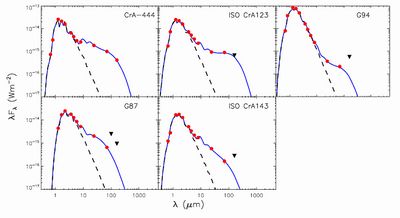On November 1, 2014, the Astrophysical Journal published a paper which reports recent results on the structure of five disks around very low mass stars and brown dwarfs in the nearby R Corona Australis region. Dr. Yao Liu is one of the co-authors of this study.
Brown dwarfs are one kind of substellar objects. Unlike main-sequence stars, their masses are too low to sustain hydrogen-fusion reactions in their cores. How brown dwarfs and very low-mass stars form is an interesting question in the field of star formation and still remains a subject of debate although several theories have been proposed, for instance, a scaled down version of star formation processes and ejection of the stellar embryo. The disk properties play a crucial role in understanding their formation.
We conducted Herschel/PACS observations of five very low-mass stars or brown dwarfs located in the nearby R Corona Australis region. Our observations, combined with previous photometry in the near- and mid-infrared regimes, enabled us to construct spectral energy distributions with extended wavelength coverage. Using sophisticated radiative transfer models, we analyzed the observed spectral energy distributions of the five detected objects and evaluated the constraints on the disk properties via the Bayesian inference method, see Figure 1. The modeling suggests that disk geometries of brown dwarfs or low-mass stars are generally similar to their higher mass counterparts like T Tauri disks, but the range of disk mass extends to well below the value found in T Tauri stars.
The work by Paul Harvey, Thomas Henning, Yao Liu (PMO), and Sebastian Wolf, is available at http://ads.bao.ac.cn/abs/2014ApJ...795...21H .

Figure 1. Observed spectral energy distributions and an example well-fitting model for each object. The dashed lines show the model photosphere, and the solid lines show the complete fitted SED.
